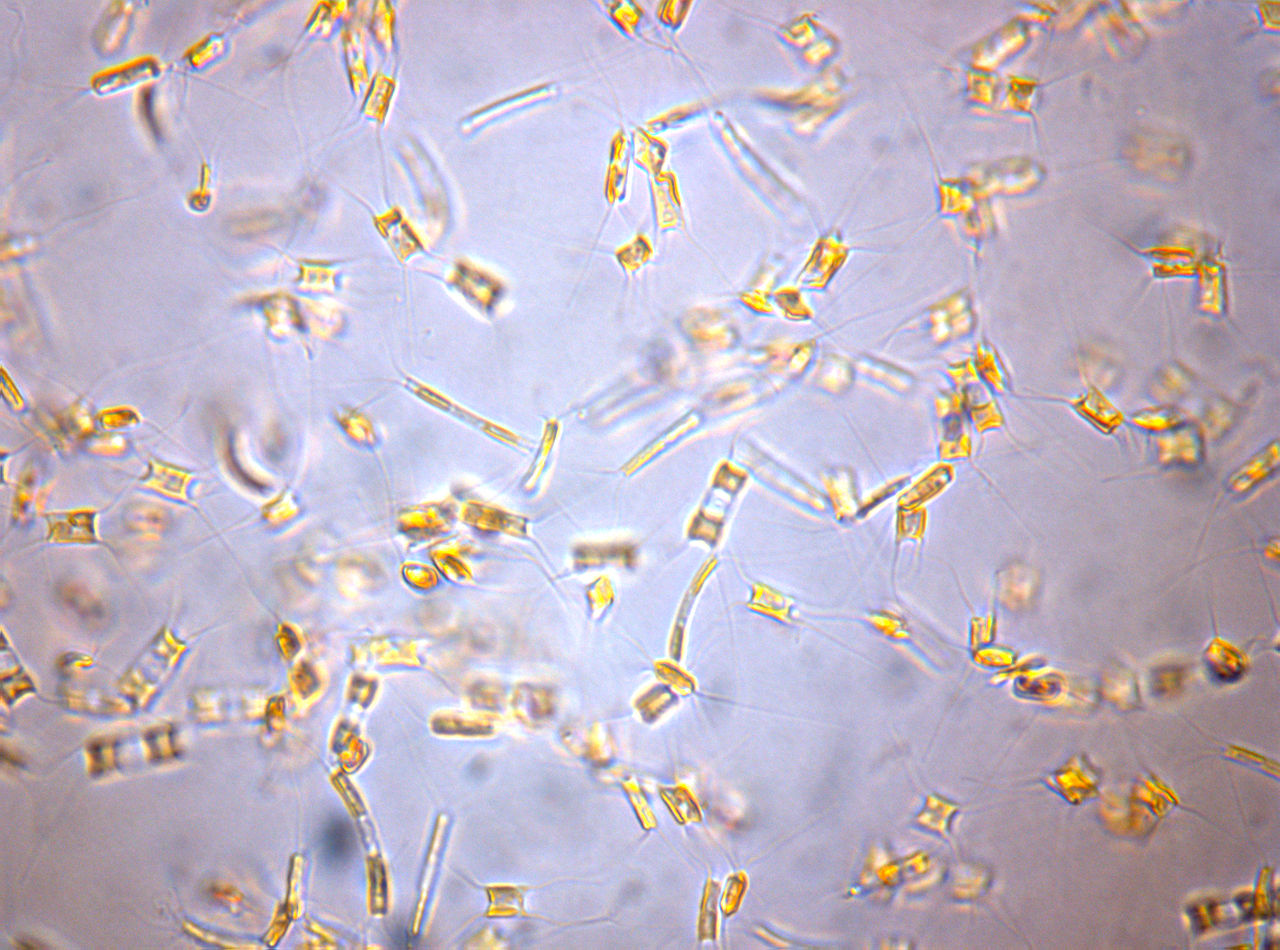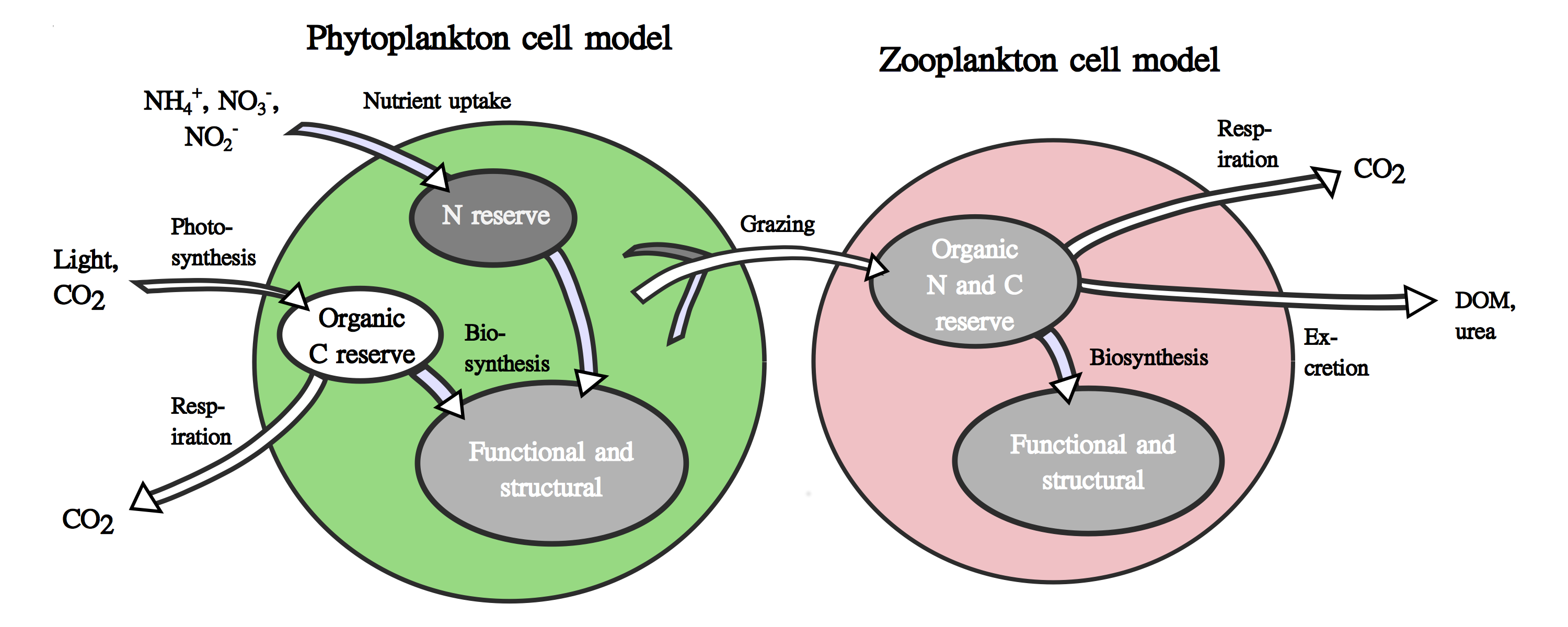
By Richard A. Ingebrigtsen, Department of Arctic and Marine Biology, University of Tromsø – Own work, GFDL, https://commons.wikimedia.org/w/index.php?curid=12614179
story by Helen Hill

This month we spotlight work by MIT Darwin Project researchers who have been using MITgcm to explore the role of microzooplankton in regulating near surface organic matter.
The elemental composition of organic matter is remarkably constant throughout the worlds oceans, but phytoplankton are known to take up nutrients and carbon in quite variable ratios depending on light and nutrient conditions. Talmy and his team were interested to explore what ecosystem factors could cause the elemental composition of organic matter to remain stable and relatively constant (homeostatic), even when the phytoplankton can have quite variable composition.
Using a combination of laboratory experiments looking at variable carbon to nitrogen ratios for different plants and animals, along with models and field observations, the authors show that interactions between primary and secondary producers are likely to be the key to maintaining homeostasis: Even when phytoplankton have carbon content that is extremely elevated, the microzooplankton that consume them may respire excess carbon, and release it back into the water as CO2.

Schematic representation of a phytoplankton cell model and a zooplankton model – Image courtesy: D. Talmy
This is likely to have an important impact on climate. The elemental composition of particulate matter in the surface ocean has significant implications for the role of the ocean in mediating atmospheric CO2. The productivity of the ocean is typically regulated by the availability of macro- and micro-nutrients and not inorganic carbon. Thus, the ratio in which carbon is associated with N, P, Fe (and other potentially limiting elemental resources) in sinking organic particles or subducted dissolved organic matter critically controls the efficiency with which carbon is transported to the deep ocean.
Talmy et al.’s results show that by comparison to microzooplankton, phytoplankton may have systematically different ratios of carbon to nitrogen. Therefore, our understanding of the ocean carbon cycle is likely to depend on our understanding of the relative contributions of these different groups to sinking organic matter.
This Month’s Featured Publication
- D. Talmy, A.C. Martiny, C. Hill, A.E. Hickman, M.J. Follows (2016), Microzooplankton regulation of surface ocean POC:PON ratios, accepted in Global Biogeochemical Cycles, doi: 10.1002/2015GB005273
Other New Publications this Month
Matthieu Chevallier et al. (2016), Intercomparison of the Arctic sea ice cover in global ocean–sea ice reanalyses from the ORA-IP project, online at Climate Dynamics, doi: 10.1007/s00382-016-2985-y
Bilel Hadri et al. (2015), Overview of the KAUST’s Cray X40 System – Shaheen II, Proceedings Cray User Group 2015, pdf
Thomas Jung et al. (2016), Advancing polar prediction capabilities on daily to seasonal time scales, Bulletin of the American Meteorological Society 2016 ; e-View, doi: 10.1175/BAMS-D-14-00246.1
Joannes Karlson (2015), Dispersion of Plastic Pellets from a Local Source; Application to a Swedish fjord system, masters thesis Department of Earth Sciences, University of Gothenburg, Sveden <hal-01251720>
Hui Shen and YiJun Hou (2016), Effects of large-amplitude internal solitary waves on ROV operation—A numerical study, online at Science China: Earth Sciences, pp 1-7, doi: 10.1007/s11430-015-5261-9
Xiaowei Wang, Shiqiu Peng, Zhiyu Liu, Rui Xin Huang, Yu-Kun Qian, and Yineng Li (2016), Tidal Mixing in the South China Sea: An Estimate Based on the Internal Tide Energetics. J. Phys. Oceanogr., 46, 107–124, doi: 10.1175/JPO-D-15-0082.1
Schönau, M.C. et al. (2015), The Mindanao Current: Mean structure and connectivity. Oceanography 28(4):34–45, doi: 10.5670/oceanog.2015.79
Ian Wong, Heather A. Knutson, Tiffany Kataria, Nikole K. Lewis, Adam Burrows, Jonathan J. Fortney, Joel Schwartz, Avi Shporer, Eric Agol, Nicolas B. Cowan, Drake Deming, Jean-Michel Desert, Benjamin J. Fulton, Andrew W. Howard, Jonathan Langton, Gregory Laughlin, Adam P. Showman, and Kamen Todorov(2016), 3.6 AND 4.5 µm Spitzer Phase Curves of the Highly-Irradiated Hot Jupiters WASP-19b and HAT-P-7b, http://arxiv.org/pdf/1512.09342.pdf
Qingxuan Yang, Wei Zhao, Xinfeng Liang, and Jiwei Tian (2015), Three-dimensional distribution of turbulent mixing in the South China Sea, Journal of Physical Oceanography 2015 ; e-View, doi: 10.1175/JPO-D-14-0220.1
Do you have news about research using MITgcm? We are looking for contributions to these pages. If you have an interesting MITgcm project (ocean, atmosphere, sea-ice, physics, biology or otherwise) that you want to tell people about, get in touch. To make a post, contact Helen
